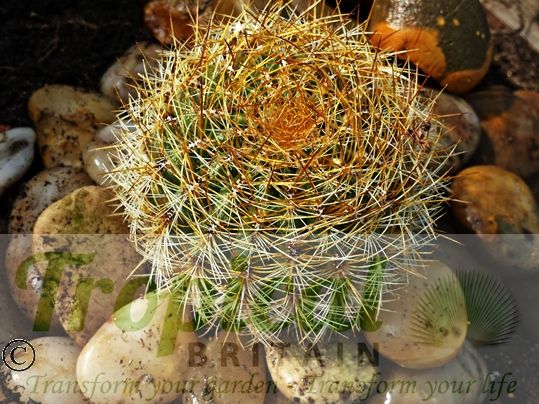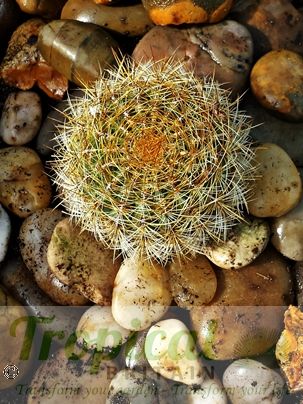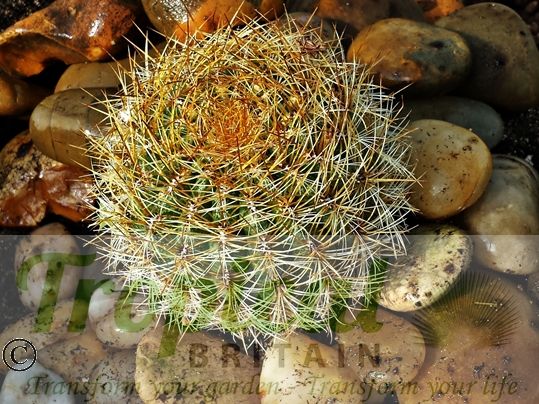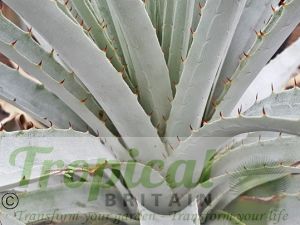Oroya peruviana
Oroya peruviana is endemic to a restricted range in the altiplano Puna grasslands of the Peruvian Andes on the high slopes and inter-Andean valleys at altitudes between about 3400-4300m above sea level. It is a small solitary globular cactus which hugs the ground, sheltering from the harsh cold relentless winds and taking advantage of the increased heat gradient close to the surface. At these altitudes the climate is cool with only a few degrees difference in seasonal average but with a wide daily range of temperatures from day to night. This diurnal variation can be as much as 45C with bright hot sunny days and frosty nights. Hard frosts and cool moist cloud cover are common with some moisture from occasional snow melt. Growing in association with grasses and other high altitude cacti like Austocylindropuntia floccosa, Oroya peruviana nestles into nooks and crannies amongst the rock and is capable of surviving occasional short dips down to -7C. Extra protection from fleece is sensible during periods of extreme winter cold when the temperature looks like it will go lower than than about -5C. Prolonged sub-zero temperatures are not normal in its natural range and fleece will provide the necessary protection in UK conditons but should be removed when temperatures pick up again and not left in place throughout the entire winter. A simple rain shelter is sensible and the small size of Oroyo peruviana make this a relatively easy proposition.
Oroya peruviana are small cacti and have evolved a low flat body shape in response to the harsh climatic regime in which it lives. To achieve this same shape in cultivation, it should be grown in high light levels, mimicking the high solar radiation at high altitude. In lower light levels, particularly during the summer growing season and without that constant driving wind coming in over the Andes they tend to grow taller and fuller. This isn't necessarily wrong - although many cactus purists think it is - it is simply an alternate shape. Plants will respond to local conditions and have differing forms. A Leptospermum scoparium, for instance, that grows on the rugged New Zealand west coast where it is exposed to constant wind will grow into a windswept shape like a large bonsai; the same plant grown in a sheltered valley will grow into a large stocky shrub; and growing in amongst secondary growth in the bush where it is competing with many others it will develop into a tall leggy tree. An Oroya peruviana growing in a typically cool and often cloudy British summer is perfectly at home but may not hug the ground quite so much trying to eke out every last degree of shelter. It will cope with British wet well providing it is in an extremely free-draining substrate. A raised sloping gradient is best.
South American cacti grow in more neutral or acidic soils than their North American relatives and in the high Puna the soils are acidic with a surprisingly high content of organic matter that has poor nutrional value and resembles peat. These soils are typically low in both nitrogen and phosphorus. Oroya derive much of their nutrients - like most cacti - from the minerals in the rock. The ideal subtrate for Oroya therefore is a free-draining mixture of grit, aggregate, and rockdust together with some general purpose potting mix without the addition of limestone. Pumice, perlite and some sand can be also be added to the mix for further drainage.
Oroya peruviana is a variable cactus and there are numerous locational forms that differ in appearance, particularly from the southern part of its range. Other species and varieties have been suggested but in the most part these have been relegated to taxonomic synonomy.
It is a species that is endangered in the wild from a wide range of threats: overgrazing by livestock and being trampled underfoot by flocks of sheep and herds of llama; being dug up during agricultural cultivation; mining activity; grassland fires and not least, illegal collection by unscrupulous collectors and impoverished locals hoping to sell them on. Some populations have already disappeared and the situation is unlikely to improve. The gene pool for this very ornamental cactus is growing smaller with every year.
Oroya peruviana is a highly desirable cactus but probably not the ideal first cactus if you are just starting to grow cacti outdoors in the UK. There are other cacti - the hardy Opuntias for instance - that are tougher and more frost hardy. But for an experienced grower who knows what they are doing, who takes the time to prepare an ideal xeric bed and who will put in the extra commitment needed in winter they are a very rewarding and relatively unusual choice.
Additional Information
| Order | Caryophyllales |
|---|---|
| Family | Cactaceae |
| Sub-Family | Cactoideae |
| Synonyms | Echinocactus peruvianus, Oroya gibbosa, Oroya gibbosa var. citriflora, Oroya laxiareolata, Oroya laxiareolata var. pluricentralis, Oroya neoperuviana, Oroya neoperuviana var. depressa, Oroya neoperuviana var. ferruginea, Oroya neoperuviana var. tenuispina, Oroya peruviana var. depressa, Oroya peruviana var. pluricentralis, Oroya subocculta, Oroya subocculta var. albispina, Oroya subocculta var. fusca |
| Geographical Origin | Peru: Apurímac, Ayacucho, Cusco, Huancavelica and Junín regions - from north of La Orroya and Tarma to south of Andahuaylas and Abancay |
| Cultivation | Full sun. Very free-draining substrate. Sheltered aspect and sloping gradient in a landscaped xeric bed |
| Eventual Height | 8cm |
| Eventual Spread | 15cm |
| Hardiness | Hardy down to about -7C for brief periods. Protect with fleece during extreme winter weather. Keep dry under a rain shelter during winter months |

Free DELIVERY
ON ALL ORDERS OVER £99THIS OFFER IS VALID ON ALL OUR STORE ITEMS.














